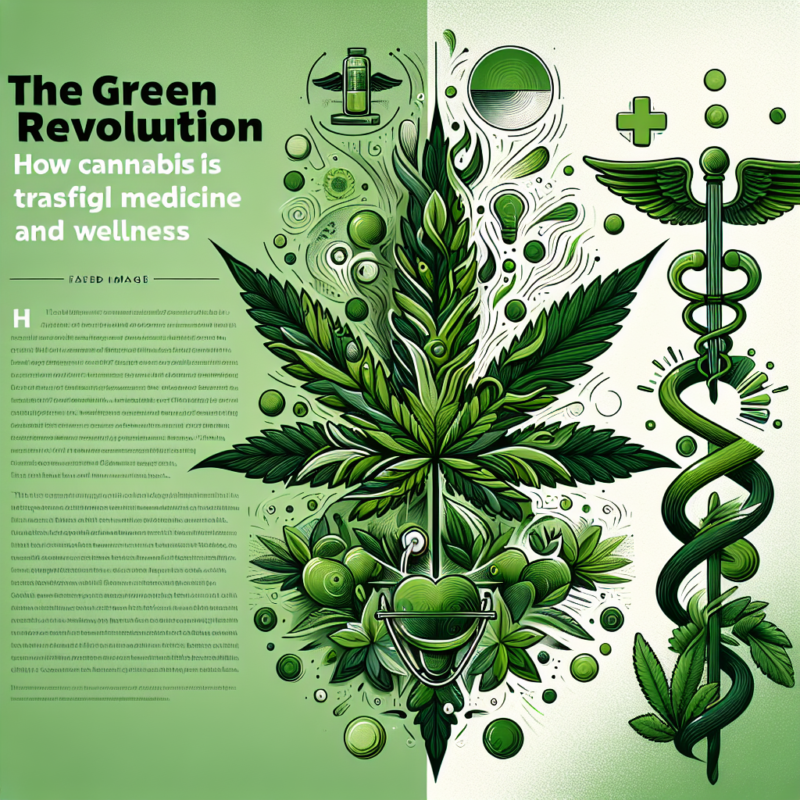The Green Revolution: How Cannabis is Transforming Medicine and Wellness
The landscape of medicine and wellness is undergoing a significant transformation, catalyzed by the increasing acceptance and legalization of cannabis. Once stigmatized as a recreational drug, cannabis is now recognized for its profound therapeutic potential, leading to a revolution in treatment options and holistic well-being. This Green Revolution, as it has come to be known, is reshaping our understanding of health, wellness, and the role of the plant kingdom in modern medicine.
A Historical Perspective
Cannabis has been utilized for medicinal purposes for thousands of years, with records dating back to ancient civilizations in China, Egypt, and India. Traditional medicine often employed cannabis for ailments ranging from menstrual pain to digestive disorders. However, the 20th century saw a steep decline in its medicinal use, primarily due to the criminalization and stigmatization of the plant. It wasn’t until the late 20th century that researchers began to rediscover cannabis’s therapeutic properties, leading to a renewed interest in its medicinal applications.
The Science of Cannabis
The interest in cannabis medicine has been fueled by scientific research that reveals the complexity and efficacy of its unique compounds. Cannabinoids, the compounds found in cannabis—most notably THC (tetrahydrocannabinol) and CBD (cannabidiol)—interact with the body’s endocannabinoid system (ECS). The ECS plays a crucial role in regulating various physiological processes, including pain sensation, mood, and immune response.
Recent studies have illuminated how cannabinoids can alleviate symptoms associated with a variety of medical conditions. For instance, THC is commonly used to manage chronic pain, stimulate appetite in patients undergoing chemotherapy, and reduce nausea. CBD, on the other hand, has gained popularity for its anti-inflammatory properties and potential to alleviate anxiety and seizure disorders, making it particularly appealing for those seeking alternatives to traditional pharmaceuticals.
Medical Applications
The growing body of evidence supporting cannabis’s therapeutic benefits has led to its legalization for medical use in many jurisdictions. Patients suffering from chronic pain, multiple sclerosis, epilepsy, and post-traumatic stress disorder (PTSD) are among those to have found relief through cannabis-based treatments.
In addition to these well-studied applications, cannabis is increasingly being explored for its potential in treating conditions such as:
-
Anxiety and Depression: As mental health awareness grows, so does the search for alternative treatments. Cannabis, especially strains high in CBD, has shown promise in helping manage anxiety and depression, providing a much-needed option for individuals who may not respond well to conventional antidepressants.
-
Neurodegenerative Disorders: Research suggests that cannabinoids could protect neurons and inhibit the progression of neurodegenerative diseases like Alzheimer’s and Parkinson’s. While much remains to be studied, initial findings are hopeful.
- Autoimmune Diseases: Cannabis’s anti-inflammatory properties have sparked interest in its role in managing autoimmune disorders such as rheumatoid arthritis and lupus, offering a potential avenue for relief when traditional treatments fall short.
Wellness and Holistic Health
Beyond clinical applications, cannabis has also found a place in the wellness movement. As holistic health continues to gain traction, cannabis-infused products—from oils and tinctures to edibles and topical creams—are increasingly being integrated into daily wellness routines. With its ability to provide relief from stress, improve sleep quality, and promote relaxation, cannabis products are becoming staples in the pursuit of holistic well-being.
The rise of CBD products, in particular, has been meteoric, as consumers seek non-psychoactive alternatives that harness the therapeutic benefits of cannabis without the high associated with THC. Companies are flooding the market with everything from CBD-infused drinks and supplements to beauty products, tapping into the growing demand for natural remedies that support overall health.
Navigating the Future
As the Green Revolution continues to unfold, it is essential to navigate the landscape with a balanced perspective. While the potential benefits of cannabis in medicine and wellness are profound, it is equally crucial to consider the need for regulation, research, and responsible use. The ongoing dialogue among healthcare professionals, researchers, policymakers, and patients will shape the future of cannabis in medicine, ensuring that it is integrated into healthcare systems safely and effectively.
Conclusion
The Green Revolution is not just a movement to legalize cannabis; it represents a paradigm shift in how we perceive and utilize natural substances in our quest for health and wellness. As we continue to uncover the potential of cannabis, both as a medicine and as a component of holistic wellness, we stand on the brink of a new era in healthcare—one where the ancient wisdom of nature melds with modern science to provide innovative solutions for a better quality of life. With continued research and open-mindedness, the future holds great promise for cannabis as a transformative force in medicine and wellness.

